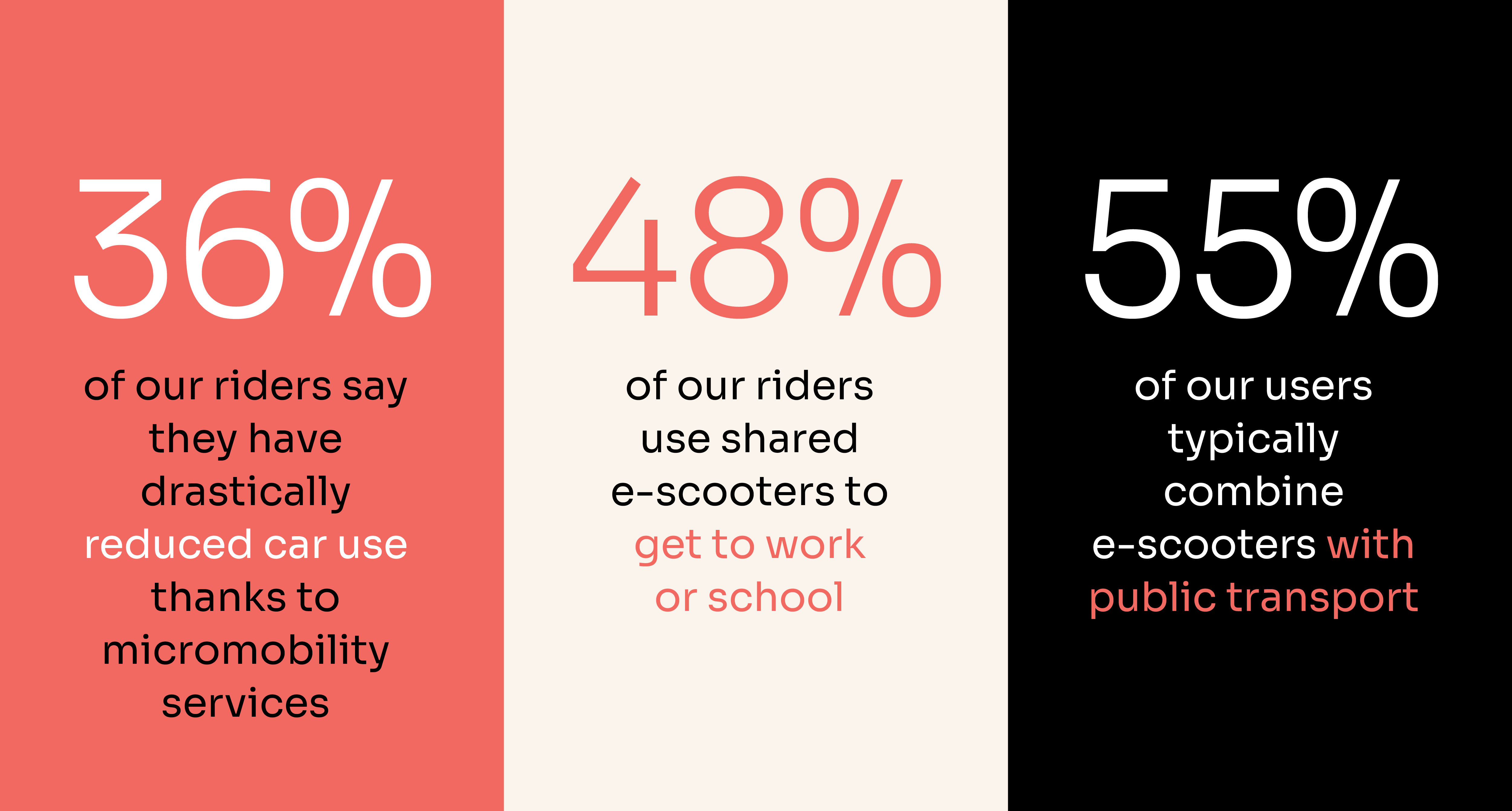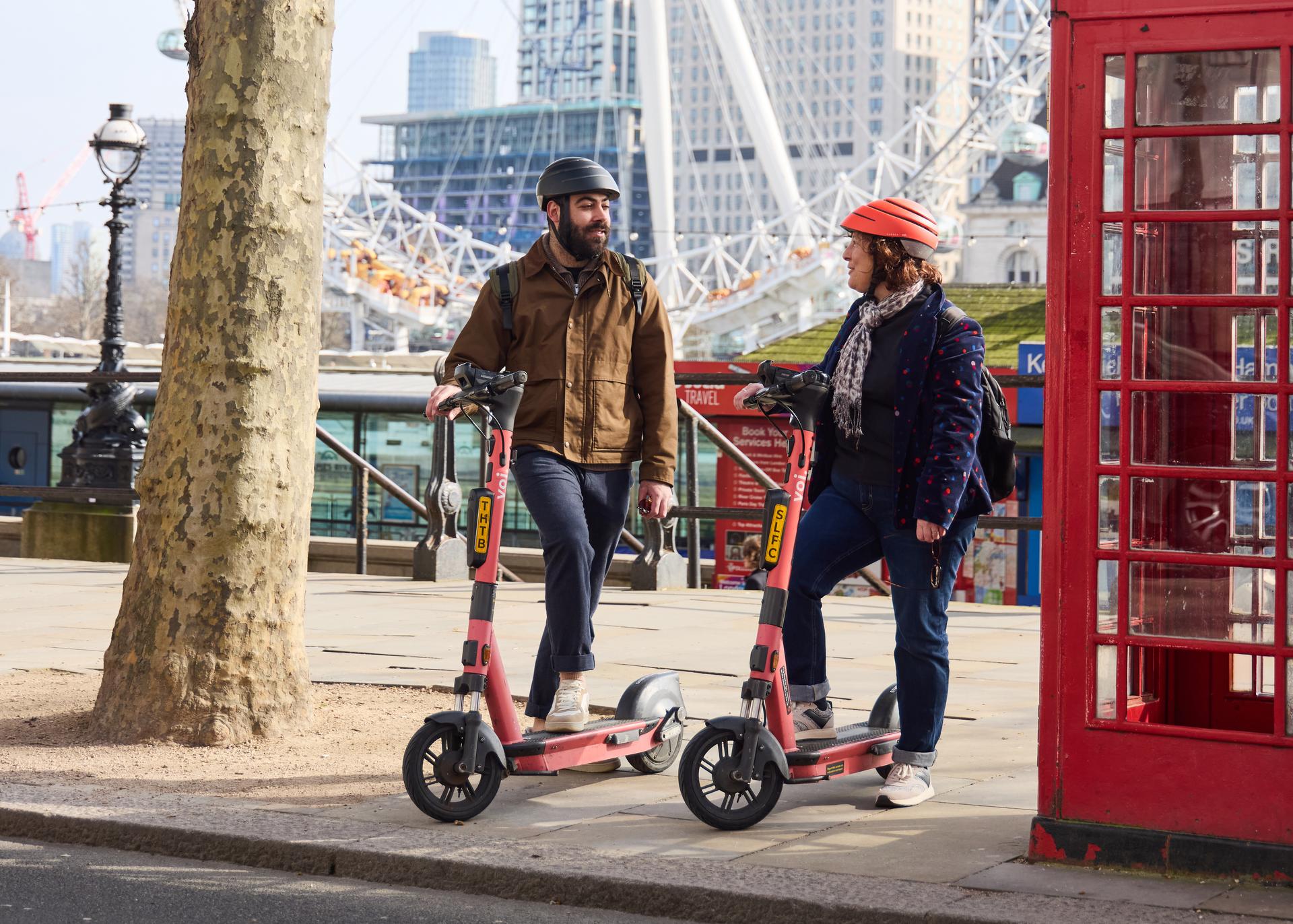Survey: One-third of users say they have drastically reduced car use thanks to micromobility services

To celebrate the day of micromobility, Voi releases a brand new global user survey bringing new perspectives on how micromobility services impact car use in cities. The results pose a good question: is it time to develop how we measure the impact of shared micromobility?
The traditional way of measuring if shared micromobility substitute cars – mode shift as the lingo goes in the industry – is to ask users what mode of transport they would have used during their last trip if e-scooters did not exist. This is what almost all mode shift studies published to date are focusing on (Wang et al. 2022).
“Micromobility services may impact car use more than previously thought.”
So has also been the case for Voi and our industry peers when using surveys to show that our services replace car trips. These surveys typically show that a substantial part of the trips with e-scooters is replacing walking, public transport and bikes – which doesn’t sit well with the sustainability claims in the industry, although we are proud that 14 % of our users say that the journey replaced a car trip.

But what if this way of measuring doesn’t give a complete picture of the impact micromobility services have on car use? To celebrate the Day of Micromobility, Voi publishes data from a new global user survey, providing new perspectives for understanding the sustainability impact of shared micromobility. We asked 10 000 of our riders how they use Voi, and the results indicate that micromobility services may impact car use more than previously thought.
Bringing flexibility to the public transport system
Is it possible that some of those replaced walking trips were in fact a part of a combined trip with another transport mode, which helped replace a car? Perhaps it helped solve the first/last mile gap for other public transport modes or provided necessary flexibility at the destination?
In fact, more than 55 % of our riders globally say that they combine the use of e-scooters with public transport, which is the most common mode to combine e-scooters with. Interestingly, the survey shows that our most frequent users are more likely to combine e-scooters with public transport, indicating that shared micromobility is complementing rather than competing with public transport.

Less joyriding and more commuting
The survey also reveals that use patterns for shared e-scooters are evolving. The top reasons to pick up an e-scooter are for travelling to social events with friends, commuting to school or work, and trips to appointments during work hours.
Compared to Voi’s user surveys from previous years, we see a significant decrease in users picking up a scooter just to ride for fun without a clear purpose. Although we are happy that people want to use our service simply because it’s a joyful experience, our goal is to enable more people to fulfil their daily needs without the need for a car. Hence, we are encouraged to see a simultaneous increase in people using shared micromobility for commuting to daily activities such as school, work or daycare. This indicates that the use of micromobility services is increasingly becoming a normalised part of users’ everyday habits.

Two-thirds of our riders say they use cars less
This year, we added a new question to our annual user survey, since we wanted to better understand how the existence of shared micromobility impacts citizens’ car use. It turns out that the impact seems to be quite significant. A bit more than one-third (36%) of users say they have drastically or fully replaced their car use thanks to the existence of shared micromobility. Another 27 % of users say they use cars slightly less than before.
This indicates that many early adopters of shared micromobility have found an alternative to car trips in urban areas. Interestingly, this effect is more prominent for people living in suburbs, who have reduced their car use to a larger extent than people living within the city centre. This may be another sign that shared micromobility is used combined with public transport, or as an option for the car in areas with poorer public transport coverage.
Furthermore, the data shows that the impact on car use is bigger in older age groups. Close to half of the users older than 45 years have reduced their car use significantly after adopting shared micromobility services. One explanation why the impact on car use m more negligible among younger individuals may be that they don’t have access to a car – more than through taxis and ride-hailing services. On the other hand, the adoption of shared micromobility services may impact young people’s future decisions on whether to buy their own car, given that shared car services are increasingly available today.

It’s important to acknowledge that this is a subjective survey question, open for interpretation. These results also bring new questions to understand the wider impact on society; for instance, how much did the users ride cars before? Still, we believe these findings are interesting and call for more research on how the existence of micromobility services impacts car dependency over time.
To date, this question has typically not been in focus in mode shift research of shared micromobility, leaving out perspectives on how this new kind of service may impact urban transport systems over time. However, a 2020 study from the Norwegian Institute of Transport Economics showed that 2 % of e-scooters riders had sold their car thanks to the existence of shared e-scooter services, and another 8 % considered doing the same. The number of respondents in this survey was low (627), but this indicates that people are willing to ditch private cars if they are offered better alternatives – which is the bigger sustainable impact potential of shared mobility according to the IPCC (p. 542).
Join the two-wheeler movement for living cities
Today more than 7 million riders have taken over 125 million rides with a Voi in Europe. And then, we are only one of several shared micromobility operators out on the street. Together with our industry peers, we are developing a brand new type of service supporting car-free access in cities.
Millions and millions of European citizens have already adopted shared micromobility services. The insights presented today indicate that early adopters have found a new way of travelling in cities, making them less reliant on cars. Together with other shared mobility solutions, we help unlock the potential to free up space in cities while making them more healthy and sustainable, as outlined in Voi’s Vision Statement.
“Unlocking the full potential of shared micromobility requires smart regulation and strong public-private partnerships.”
All of this has happened in just a couple of years. Today, it’s four years since Voi put the first e-scooters on the streets in Stockholm, as one of the first European operators in a massively growing micromobility industry. There’s clearly a demand for this type of service, and everyone is invited to become a part of the two-wheeler movement for living cities.
Unlocking the full potential of shared micromobility requires smart regulation and strong public-private partnerships to make these services more accessible and inclusive, while reducing adverse impacts on other road users. Furthermore, it’s necessary to ramp up traffic education, given that unused road users are now hitting the streets on two-wheelers. Voi pledges to continue collaborating with cities on our mission of bringing safe, sustainable and reliable micromobility to the streets of Europe.
About the survey
The survey was sent out by email to a random sample of Voi users in July. We received 9,898 responses from users across all 11 countries Voi operates in. The survey included around 25 questions, including one segmentation question to only include eligible users and a disqualification question to exclude invalid answers.
Learn more in our Vision Statement and guide to best practices in Shared Micromobility Tenders




